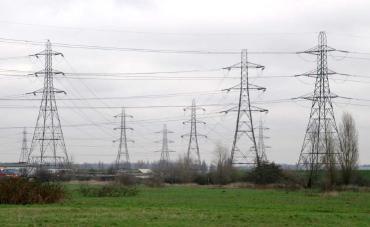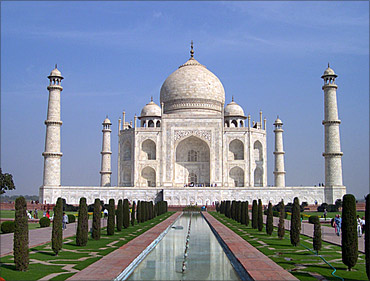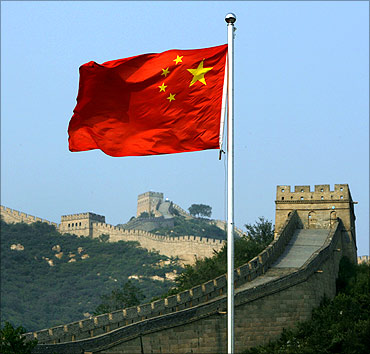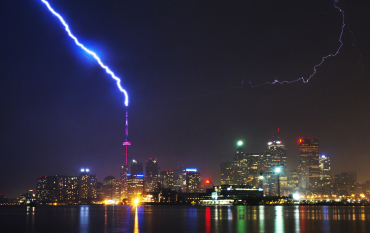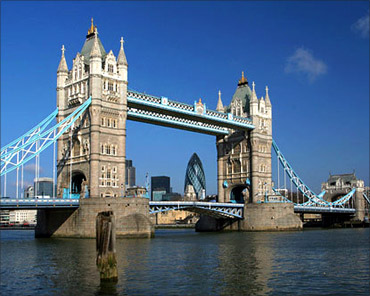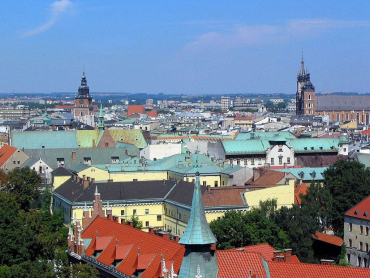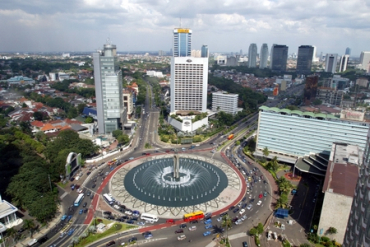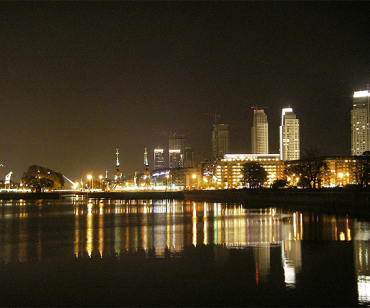 | « Back to article | Print this article |
World's biggest electricity producers
There are some countries that are generating so much electricity that they are able to export a good part of it, while some countries struggle to meet even domestic demand.
Let us first have a look at where India stands.
Click NEXT to read more...
World's biggest electricity producers
Production: 723.8 (billion kWh)
The country's annual energy production increased from about 190 billion kWh in 1986 to more than 837 billion kWh in 2010.
The Indian government has set a modest target to add about 78,000 MW of installed generation capacity by 2012, which it is likely to miss.
Four major economic and social drivers characterize the energy policy of India: a rapidly growing economy, increasing household incomes, limited domestic reserves of fossil fuels and the adverse impact on the environment of rapid development in urban and regional areas.
Currently, India is the fifth-biggest producer of electricity.
Click NEXT to see the top 28 countries...
World's biggest electricity producers
Production: 4,110 (billion kWh)
United States continues to get most of its electrical production from conventional thermal power plants.
Most of these are coal; however, the 1990s and 2000s have seen a disproportionate increase in natural gas and other kinds of gas powered plants.
Click NEXT to read more...
World's biggest electricity producers
Production: 3,451 (billion kWh)
China has abundant energy. The country has the world's third-largest coal reserves and massive hydroelectric resources.
But there is a geographical mismatch between the location of the coal fields in the north-east and north, hydropower in the south-west, and the fast-growing industrial load centers of the east and south.
Click NEXT to read more...
World's biggest electricity producers
Production: 956.5 (billion kWh)
In 2008, the power sources for electric energy were 27 per cent from coal, 26 per cent from gas, 13 per cent from oil, 24 per cent from nuclear power, and eight per cent from hydro power.
Click NEXT to read more...
World's biggest electricity producers
4. Russia
Production: 925.9 (billion kWh)
In 2008, the end use of electricity was 4.3 per cent of the world total.
In 2008, the gross production of electricity was 5.1 per cent of the world total. The share of natural gas fuelled electricity was 48 per cent of the gross electricity production in 2008.
The share of coal and peat electricity was 19 per cent of the gross electricity production.
Click NEXT to read more...
World's biggest electricity producers
Production: 620.7 (billion kWh)
Canada is the world's second-largest producer of hydroelectricity, which accounted for 58 per cent of all electric generation in 2007.
Since 1960, large hydroelectric projects, especially in Quebec, British Columbia, Manitoba and Newfoundland and Labrador, have significantly increased the country's generation capacity.
In Ontario, Canadian-designed CANDU nuclear reactors supplied more than half the provincial electricity demand in 2007.
Click NEXT to read more...
World's biggest electricity producers
Production: 593.4 (billion kWh)
Germany, the largest exporter of electricity with 10 per cent of the overall exports, reinforced its position as a net exporter by 20 per cent during the year 2010.
Germany was in the fourth position for coal-produced power after China, the US and India.
Click NEXT to read more...
World's biggest electricity producers
Production: 535.7 (billion kWh)
In 2009, 76 per cent electricity was produced with nuclear power, 14 per cent with renewable sources and 10 per cent with fossil fuels.
France has the largest share of nuclear electricity in the world in its grid. The production of nuclear power in France decreased 12 per cent in 2009 compared to 2004 equivalent to eight per cent units share less nuclear power.
It was almost equal to seven per cent drop in electricity export.
Click NEXT to read more...
World's biggest electricity producers
Production: 438.8 (billion kWh)
The country has the largest capacity for water storage in the world, being highly dependent on hydroelectricity generation capacity, which meets over 80 per cent of its electricity demand.
This reduces the country's generation costs relative to countries with more diverse supply mixes.
However, this dependence on hydropower also makes Brazil especially vulnerable to power supply shortages in drought years, as was demonstrated by the 2001-2002 energy crisis.
Click NEXT to read more...
World's biggest electricity producers
Production: 417 (billion kWh)
South Korea placed a heavy emphasis on nuclear power generation. The country's first nuclear power plant, Kori Number One located near Pusan, opened in 1977.
The government decision in July 2008 to increase investment in renewable energy to reduce reliance on foreign oil imports may provide incentive for conglomerates' solar plans.
Click NEXT to read more...
World's biggest electricity producers
Production: 368.6 (billion kWh)
By 2004, coal use in power stations had fallen by 43.6 per cent compared to 1980 levels, though up slightly from its low in 1999.
From the mid 1990s new renewable energy sources began to contribute to the electricity generated, adding to a small hydroelectricity generating capacity.
The UK government energy policy expects that the total contribution from renewables should rise to 10 per cent.
Click NEXT to read more...
World's biggest electricity producers
Production: 300.5 (billion kWh)
In 2009, Spain produced 13 per cent wind power compared to the use of electricity.
The wind capacity installed at end 2010 will, in a normal wind year, produce 14.4 per cent of electricity, when the equivalent value for Germany is 9.4 per cent, Portugal 14 per cent and Denmark 24 per cent.
Click NEXT to read more...
World's biggest electricity producers
Production: 289.7 (billion kWh)
Italy does not have nuclear power due to a public vote. Italy voted against nuclear power after public voting in 1987 after the Chernobyl disaster.
According to the National Renewable Energy Action Plan Italy will not meet its 17 per cent renewable electricity share target in 2020.
Click NEXT to read more...
World's biggest electricity producers
Production: 245 (billion kWh)
Total electricity coverage in Mexico is 97 per cent, being almost 100 per cent in urban areas and around 95 per cent in rural ones.
The generation sector was opened to private participation in 1992. However, the state-owned utility, is still the dominant player in the generation sector, with two-thirds of installed capacity.
Click NEXT to read more...
World's biggest electricity producers
Production: 240.3 (billion kWh)
South Africa was 6. top hard coal producer in 2009. Hard coal production was 1,620 TWh in 2009 and total energy production 1,995 TWh in 2008.
Coal production and use creates in South Africa coal combustion wastes, coal mine wastes and toxic coal land fires.
Click NEXT to read more...
World's biggest electricity producers
Production: 239.9 (billion kWh)
In Australia, green energy is accredited under the GreenPower scheme whereby all distributors are government audited bi-annually to ensure that customers are getting exactly what is described in their purchased products.
In the 2009 settlement period there were 904,716 GreenPower customers Australia-wide, accounting for a total of 2,194,934 MWh of electricity generation, a 10 per cent increase over 2008.
Click NEXT to read more...
World's biggest electricity producers
Production: 229.1 (billion kWh)
The Taiwan government has been active in promoting energy efficiency, and set a target of energy efficiency of 33 per cent by 2025.
The government is currently assisting 200 major energy users (companies and organizations) in implementing energy-saving measures.
Taiwan is preparing for the age of high oil prices, and is proactively developing clean energy, such as solar and wind power and biofuels.
The efforts would help reduce Taiwan's reliance on imported oil, while contributing to the reduction of greenhouse gases.
Click NEXT to read more...
World's biggest electricity producers
Production: 212.8 (billion kWh)
Iran's domestic consumption and production have steadily grown together since 1984 and it is still heavily reliant on traditional thermal energy sources of electricity, with a small fraction being produced by hydroelectric plants.
Today, Iran ranks 17th-largest producer and 20th-largest consumer of electricity in the world.
Click NEXT to read more...
World's biggest electricity producers
Production: 198.4 (billion kWh)
As of 2005, Turkey had the fifth-highest direct usage and capacity of geothermal energy in the world.
It is stated that at least 1.5 million houses currently heated by natural gas can switch to being heated by thermal waters.
Click NEXT to read more...
World's biggest electricity producers
Production: 179.1 (billion kWh)
Electricity generation is 65 per cent from oil, 27 per cent from natural gas and eight per cent from steam.
A looming energy shortage requires Saudi Arabia to increase its capacity.
The government has approved the construction of a $300 million dollar facility to turn waste into energy.
The facility will process 180 tonnes of waste per day, producing 6MW of electricity and 250,000 gallons of distilled water.
Click NEXT to read more...
World's biggest electricity producers
Production: 172.9 (billion kWh)
Ukraine was the eighth-highest nuclear electricity producer in 2009. More than 46 per cent of domestic electricity generation was nuclear. This was second highest, with only France higher.
Energoatom is the state nuclear company established in Kiev.
Click NEXT to read more...
World's biggest electricity producers
Production: 149.1 (billion kWh)
In 2009, Poland was world's ninth-largest hard coal producer. The country is also the second-largest coal consumer in Europe behind Germany.
The Polish government has plans to reach 2,000 MW in wind power capacity and a 2.3 per cent share of wind generation in domestic energy consumption.
Click NEXT to read more...
World's biggest electricity producers
Production: 148.20 (billion kWh)
In 2008, power generated from natural gas-fired power plants of the Electricity Generating Authority of Thailand, Independent Power Producers and Small Power Producers accounted for a share of 70 per cent of the total power generation.
Next to natural gas were such "solid fuels" as lignite, constituting 12.6 per cent, and imported coal of which the quality is better than lignite, representing 8.2 per cent.
Click NEXT to read more...
World's biggest electricity producers
Production: 144 (billion kWh)
More than a third of Sweden's energy supply depends on imports. Domestic energy production is largely limited to electricity generation using nuclear energy and renewable sources (almost exclusively hydro).
Energy imports are mainly oil from Denmark, Norway and Russia, with some small quantities of hard coal imports.
Click NEXT to read more...
World's biggest electricity producers
Production: 142.7 (billion kWh)
Electricity generation in Norway is almost entirely from hydroelectric power plants.
Norway was the first country to generate electricity commercially using sea-bed tidal power.
A 300 kilowatt prototype underwater turbine started generation in the Kvalsund, south of Hammerfest, on November 13, 2003.
Click NEXT to read more...
World's biggest electricity producers
Production: 129 (billion kWh)
Although Indonesia generates 86 per cent of its electricity from conventional thermal sources (coal, gas, and oil), it was the third-largest generator of geothermal power in 2009.
Click NEXT to read more...
World's biggest electricity producers
Production: 118.4 (billion kWh)
Egypt's installed generating capacity stood at 23.4 gigawatts as of 2008, with plans to further expand capacity through additional investments in natural gas, nuclear and renewable energy.
Click NEXT to read more...
World's biggest electricity producers
Production: 113.3 (billion kWh)
The main electricity source is hydropower, which accounted for 71 per cent in 2004. In 2004, Venezuela produced 70 TWh of hydropower, which accounts 2.5 per cent of world's total.
At the end of 2002, total installed hydroelectric generating capacity accounted 13.76 GW with additional 4.5 GW under construction and 7.4 GW of planned capacity.
Click NEXT to read more...
World's biggest electricity producers
28. Argentina
Production: 109.5 (billion kWh)
Faced with rising electricity demand (over six per cent annually) and declining reserve margins, the government of Argentina is in the process of commissioning large projects, both in the generation and transmission sectors.
To keep up with rising demand, it is estimated that about 1,000 MW of new generation capacity are needed each year.
An important number of these projects are being financed by the government through trust funds, while independent private initiative is still limited.
